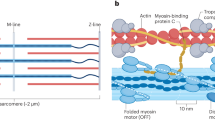Play all audios:

Recently, two of us (M.Y. and H.S.) described an apparatus, termed the stream cell, in which a circulating flow could be induced by the interaction of heavy meromyosin (HMM) with F-actin
(filamentous actin), purified from rabbit skeletal muscle1–5. Here we describe a novel system, the actomyosin motor, consisting of a rotor with F-actin attached which rotates in a specific
direction, driven by the ATP-hydrolysing interaction of HMM with F-actin. This actomyosin motor can be prepared much more easily than the stream cell, and motor activity was observed with
almost 100% success when the experiment was done carefully. This system represents a novel biological motor which, like the stream cell, is suitable for studying the chemo-mechanical
coupling of actin and active myosin fragments.
Anyone you share the following link with will be able to read this content:
